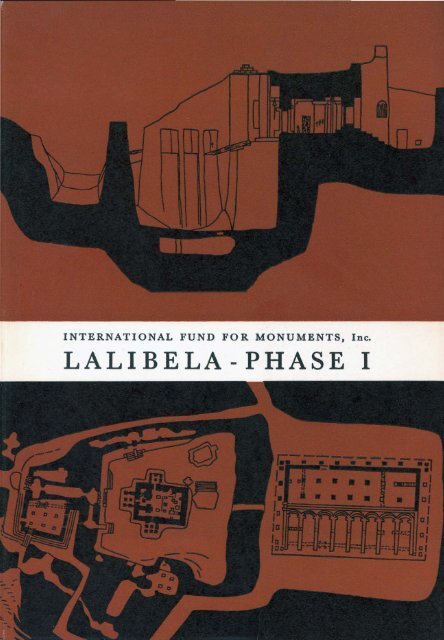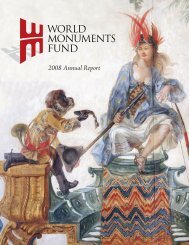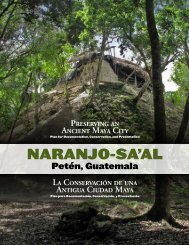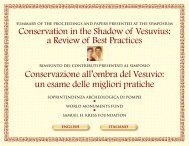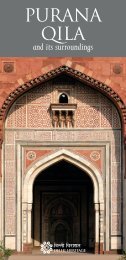Lalibela, Phase I (pdf) - World Monuments Fund
Lalibela, Phase I (pdf) - World Monuments Fund
Lalibela, Phase I (pdf) - World Monuments Fund
You also want an ePaper? Increase the reach of your titles
YUMPU automatically turns print PDFs into web optimized ePapers that Google loves.
INTERNATIONAL FUND FOR MONUMENTS, Inc.<br />
LALIBELA - PHASE I
Ethiopian Committee<br />
H. H. Princess Ruth Desta<br />
Chairman<br />
H. E. Haile Giorghis<br />
Ministu 01 P-uhlic Works<br />
H. E. Abebe Retta<br />
Ministe,. oj Commel'C8 and Industry<br />
Mr. Tatlara Degue!e<br />
Manager, Commercial Bank 01 Ethiopia<br />
Dr. Francis Anfray<br />
Chief. French Af'chaeological Mission<br />
Mr. Mirrit Boutros Ghali<br />
President, Society toy Coptic Archaeology<br />
Mr. Pierre Petridis<br />
Advisor, Ministry oj Public Works<br />
Mr. Aferwek Tekle<br />
N alional A ,tist<br />
International <strong>Fund</strong><br />
for <strong>Monuments</strong>, Inc.<br />
Mr. Charles M. Grace<br />
Chainnan<br />
Dr. Edmundo Lassalle<br />
Vice-Chairman<br />
Mr. L. Baneel LaFarge<br />
A"chitecl<br />
Dr. John O. Brew<br />
Dir8ctOt'. Peabody Museum,<br />
Harvard University<br />
Dr. Piero Gazzola<br />
P"sidenl, [COMaS<br />
Mrs. Jacqueline Dwyer<br />
Treasu,e1'<br />
Mr. Francis X. Maloney<br />
Secretary<br />
Col. James A. Gray<br />
Executive DirectoY<br />
Technical Staff<br />
Architect Sandra Angelini<br />
Project Di"ectoy<br />
Architect Marialuisa Angelini<br />
A ssistant A,.chitect<br />
lng. Giulio Bonorandi<br />
Static Engineer<br />
Mr. Francesco Salvi<br />
A rchitectuf'td Restorer<br />
Mr. Giuseppe Arrigoni<br />
Paintings Restorer<br />
Geom. Sergio Giudici<br />
Suroeyor-drajtsman<br />
Mr. Guy Boghossian<br />
Liaison and Administration
King. <strong>Lalibela</strong>.<br />
A canvas in Biet Micael XVII Century.<br />
Fronterspiece of first issue of<br />
Portuguese chronicle of Padre Alvarez 1540 A.D.<br />
HISTORY OF THE CHURCHES<br />
The exact ongms of the eleven churches of<br />
<strong>Lalibela</strong> are shrouded in the mists of time. They<br />
may have been created over a long period oftime<br />
by successive regimes, but an Ethiopian legend<br />
has it that they were produced during 23 years<br />
by Emperor <strong>Lalibela</strong> ofthe Zague dynasty, which<br />
ruled the country in the 12th Century A. D.<br />
There is evidence that Copt craftsmen from Egypt<br />
or Jerusalem did the main « construction» work,<br />
and that Indian artisans may have decorated the<br />
interiors.<br />
Some think that the churches may have been<br />
inspired as the result of a visit of the Queen of<br />
Sheba to Jerusalem about 1,000 B. C., but it is<br />
more widely believed that they were dug out to<br />
form a new Jerusalem after Moslem conquests<br />
halted the Christian pilgrimages to the Holy<br />
Land. Some substantiation for this theory is<br />
found in the place names such as: River Jordan<br />
and Mount Tabor (in <strong>Lalibela</strong>) and Bethlehem<br />
and other Biblical names scattered about Ethiopia,<br />
which remained Christian since the Fourth<br />
Century - the only country in Africa to do so.<br />
An old Ethiopian chronicle relates: « To save<br />
sinners from perdition, the Saviour of the <strong>World</strong><br />
made this promise to King <strong>Lalibela</strong>: Whoever comes<br />
II
in pilgrimage to your sanctuary will acquire the same<br />
merits as those who have made the pilgrimage iho the<br />
HolY Sepulchre (Jerusalem) .. and so he continues<br />
confirming the value of Lalibe1a as aHoly City. »<br />
What little is known of the history of the<br />
churches comes from early travellers, scholars and<br />
archaeologists. The Portuguese Jesuit explorer<br />
Francisco Alvarez wrote about 1540: «Buildings<br />
the like of which and so many cannot be found<br />
in the world .. I weary of writing. more about<br />
them because it seems to me I would not be<br />
believed .. »<br />
DESCRIPTION OF THE CHURCHES<br />
As Alvarez discovered, the churches were not<br />
constructed according to traditional methods but<br />
were hewn from the living rock in massive<br />
rectangular blocks. Out of these blocks the<br />
craftsmen chiseled and carved edifices with ornate<br />
roofs and ceilings, walls 30 to 50 feet high, floors<br />
on varying levels, individual rooms, windows,<br />
columns and arches. They surrounded the churches<br />
with an extensive system of drainage ditches and<br />
defensive trenches in a finished work that was a<br />
gigantic accomplishment in engineering and<br />
architecture. As one basis of comparison, and<br />
not counting the extensive additions uncovered<br />
by Dr. Angelini, it is startling to note that the<br />
volume of rock dug out was five times that<br />
involved in the creation of the two temples of<br />
Abu Simbel in Upper Egypt.<br />
Architecturally, the work seems to have been<br />
influenced more by the underground Coptic<br />
churches in Egypt than by the cave churches<br />
which abound throughout Ethiopia. The <strong>Lalibela</strong><br />
churches exhibit traces ofByzantine influence and<br />
their workmanship and design must have<br />
originated in the artistic centers of the Eastern<br />
Mediterranean. The end result is a complete<br />
church in a single mass attached only at the base<br />
to the contiguous mountain.
PLAN OF FIRST GROUP OF CHURCHES<br />
1. Trench.<br />
2. Tomb of Adamo.<br />
3. Biet·Golgotha Micael.<br />
4. Crypts.<br />
5. Passage to tomb block.<br />
6. Ancient subterranean passages.<br />
7. Entrance to courtyard of Biet Mariam<br />
8. Biet MaseaI.<br />
9. Biet Denagel.<br />
10. Small pool.<br />
11. Courtyard of Biet Mariam.<br />
12. Biet Mariam.<br />
13. Courtyard of Medani Alem and trenches.<br />
14. Medani Alem:<br />
(From Della Corte and Bidder),<br />
Opposite page: Aerial photo of First Group courtesy of National Geographic<br />
Magazine 1965.
Biet Mascal.<br />
cracks and fissures have opened up - some of geological<br />
origin, and others the result of shifting of sections of rock.<br />
The principal villain has been the intensive rainfall during<br />
summer months throughout the centuries. Another element of<br />
destruction has been the slow, constant penetration ofroots into<br />
the crevices, as at Angkor Wat in Cambodia, and to lichens<br />
and microvegetation attacking the walls and roofs:<br />
Biet Giorgis.<br />
Sculptured mound viewed from courtyard of Biet Mariam.<br />
«RESTORATIONS» OF THE PAST<br />
Many «restorations » have been undertaken, most within<br />
the past few decades, and have generally injured, rather<br />
than improved the monuments. Some works, such as the<br />
construction of stairways and partitions, were done for the<br />
convenience of the priests and have disturbed the artistic<br />
integrity of the churches. In two cases, Biet Amanuel and Biet<br />
Medani Alem, the exterior walls were coated with tar and<br />
then covered with an incongruous red paint - a treatment<br />
21
Project headquarters.<br />
which halts the natural breathing of the rock. The roofs of<br />
these two churches were sheathed with corrugated metal,<br />
completely destroying their original monolithic appearance.<br />
Here and there cornices and pillars were rebuilt with little<br />
grace but with much cement.<br />
PROGRESS REPORT ON PHASE I<br />
Dr. Angelini reports that, without an additional dollar<br />
in costs, the Ethiopian workers and his team of Italian<br />
specialists were able to complete three times the e.xtent of<br />
restorations and excavations forseen in his estimate - this<br />
Pay Day.<br />
Arrival of equipment.<br />
despite the problem of training the workers, the poor<br />
communications, slow arrival of equipment, and the fact that<br />
the work had to be conducted in the midst of daily services<br />
in the churches.<br />
The guiding principle of his preservation effort is to<br />
safeguard the churches from further deterioration, remove<br />
false additions, and to reestablish where esthetically permitted,<br />
the monolithic form and character that they once had. This<br />
latter is effected by a build-up of damaged or destroyed areas<br />
with a mixture of crushed local stone and neutral cement<br />
molded to the original form and color but with a different<br />
exterior texture.<br />
Although much static strengthening remains to be done<br />
during a second phase, the team consolidated many cracks and<br />
fissures in places that showed imminent danger of collapse.<br />
This was done by injecting a cement of high adhesive and<br />
expanding qualities and, where indicated, by inserting steel<br />
reenforcing rods. In the case of one church, Biet Mariam,<br />
heavy repairs of this nature were necessary after the removal<br />
of recent additions which had covered gaping cracks and<br />
seriously weakened walls.<br />
In the field of protective restoration, the team applied a<br />
water-repellent solution to the worst areas of the roofs of four<br />
churches - Biet Mariam, Biet Medani Alem, Biet Denagel,<br />
and Biet Micael. As an additional measure, they covered the<br />
roof of Medani Alem with sheets of polyethylene, a plastic<br />
shield which will be removed when we complete the<br />
restorations during <strong>Phase</strong> II.<br />
In the sector of correcting previous «restorations », the<br />
most tedious and time-consuming task was the removal of the<br />
tar-based paint from the exterior walls of Medani Alem and<br />
Biet Amanuel. The tar coating foiled efforts to clean the<br />
surface by scraping, sanding, burning, or the use of chemicals<br />
(acids .and solvents) because the heat thus generated<br />
imbedded the tar more deeply into the porous stone.
A corner of Biet Mariam reconstructed<br />
with modern brick and cement.<br />
Same corner after removal of incongruous<br />
additions but before restora M<br />
tion to monolithic form and appearance.<br />
Lower photos :"A small pillar in the courtyard of Biet Mariam; before, during,<br />
and after restoration.<br />
Utilizing epecially constructed picks, workmen patiently flake away the tar<br />
and red paint from the walls of Medani Alem, a task which could be accomplished<br />
only during the cooler hours of the day when the tar is brittle.
The heavy layer of grey cement being carefully chipped away from the, roof<br />
of Medani Alem to expose the original monolithic surface.<br />
Fortunately, it was discovered that during the cooler hours<br />
of the day when the tar was brittle, by lightly tapping the<br />
surface with a pointed instrument, the tar flaked away about<br />
a square inch at a time, carrying with it the red paint. Fifty<br />
small picks with case-hardened points were flown in from<br />
Italy and the slow and systematic job was begun. At the end<br />
of <strong>Phase</strong> I, about two-thirds of the more than 30,000 square<br />
feet of painted surface had been cleaned.<br />
The corrugated metal covering of the roof of Medani Alem<br />
was removed and a heavy layer of cement underneath was<br />
Workmen sealing and binding<br />
cracks and crevices found in roof<br />
of Medani Alem.<br />
A section of the roof of Medani Alem<br />
after removal of «recently» added layer<br />
of cement, and showing the details of<br />
the bas-relief of large arches.<br />
Biet Mercoreos: View between supporting pillars. Left photo showing<br />
« recently» added partitions which we removed during <strong>Phase</strong> I (right photo)<br />
to restore original floor plan.
painstakingly chipped away to expose once more the original<br />
naked stone with its bas-relief of large crosses and arches.<br />
Here and there on the various churches the team' removed<br />
sections of cornices and pillars that had been crudely rebuilt<br />
with modern brick and cement. Much of the work to restore<br />
these features to their original monolithic appearance will be<br />
done during the second phase.<br />
The team's art restorer devot.ed most of his time t.o saving<br />
the frescoes and paint.ings in Biet Mariam, t.he richest.<br />
repository of such art, and complet.ed 95 % of the t.ask of<br />
cleaning, «fixing », and restoring (where indicated) these<br />
Biet Amanuel, which at first glance appears as though it were constructed<br />
rather than sculptured, and with an architecture of a much later period,<br />
but actually a splendid example ofAxumite style.<br />
A fresco within Biet Mariam after restoration.<br />
works. Various ot.her art object.s, such as canvases, decorative<br />
shields, small t.ables and screens have been st.ored in t.he<br />
Governor's headquart.ers t.o await rest.orat.ion during the<br />
second phase.<br />
29
Biet Mariam: Above, frescoes painted on undersurface of interior arch<br />
showing sun and two flower designs. Below, two bulls with white bull<br />
symbolizing good and the black bull evil. On the right, a fantasy of bird<br />
figures.<br />
Biet Mariam: Wall above altar after restoration.<br />
Interiors of all churches of <strong>Lalibela</strong> are highly decorated with saints, holy<br />
scenes, symbols, and geometric designs.
Copper plate unearthed at Biet<br />
Mercoreos.<br />
A typical cross of <strong>Lalibela</strong>.<br />
Below: Two examples of sacred stools called « menvers n.<br />
Above: Two of the decorative shields from Medani Alem.<br />
This page and opposite: Articles within the churches which became part<br />
of photographic inventory and must be preserved as essential and configurative<br />
elements in the life of the churches.<br />
A censer.<br />
Sistrums.
EXCAVATIONS<br />
By ingenuity, Dr. Angelini and his co-workers were able<br />
to achieve a much greater volume of archaeological<br />
excavations than originally planned. The native work force<br />
was increased from 200 to 400 and a primitive trolley-andcable<br />
bucket system was introduced to enable them to reduce<br />
radically the time and effort to remove the excavated earth<br />
to a satisfactory distance from the site - always a major<br />
problem in an archaeological excavation.<br />
Although the bulk of the 15,000 cubic yards of digging<br />
was designed to ensure adequate drainage of rainwater by<br />
exposing again the portions of the complex which had been<br />
covered over, and to impede the washing of rubble and stones<br />
into the courtyards, Dr. Angelini reports that he soon became<br />
fascinated with important historical discoveries. Digging in<br />
the area adjacent to Biet Mercoreos uncovered fragments of<br />
ancient pottery, a large copper plate of Oriental origin<br />
(probably from India), and iron tethers for chaining prisoners.<br />
Dr. Angelini belieyes that these findings support his theory<br />
that Biet Mercoreos was originally not a church, but the civil<br />
palace of a ruler who may have predated King <strong>Lalibela</strong>.<br />
The project director adds that, with the uncovering ofmany<br />
deep trenches and ditches, nearly all of the perimeter of this<br />
walled and moated city has been traced, and that if these<br />
excavations are adequately pursued, the aspect of the eleven<br />
single churches will be converted into a gigantic, integrated<br />
shrine and a sC1,llptured mountain - an important attraction<br />
for tourists, a laboratory for scholars, and a great ctiltural gift<br />
to the world. .<br />
34<br />
Upper photos: A previously unknown trench below Mount Tabor uncovered<br />
during <strong>Phase</strong> 1. Before and after. Lower photos: Another section of the<br />
same trench. Before and after excavations.
Another previously unknown trench<br />
which connects the two groups<br />
of churches on their high side.<br />
The large monolithic cross uncovered<br />
in River Jordanos and believed to have<br />
played a part in religious ceremonies.<br />
Below Biet Mascal: Part of a trench system previously entirely unknown.<br />
A trench connecting Mount Tabor with River Jordanos and which was<br />
completely covered over and unknown.
Additional copies of this booklet<br />
may be obtained from:<br />
International <strong>Fund</strong> For <strong>Monuments</strong>, Inc.<br />
15 Gramercy Park, New York,<br />
N. Y. 10003


